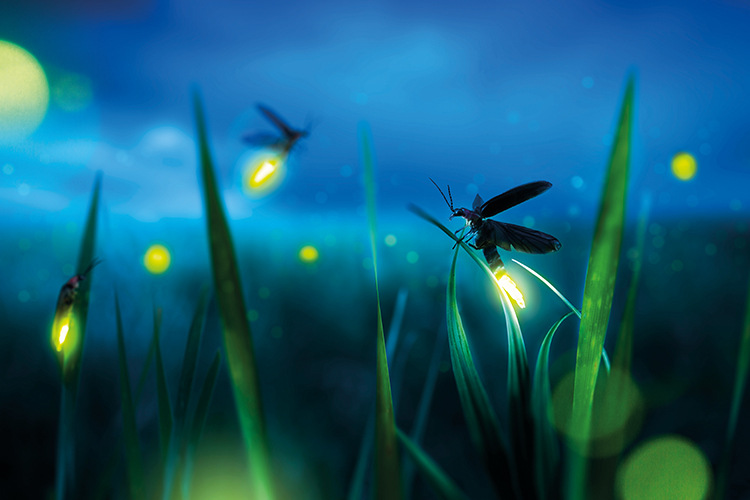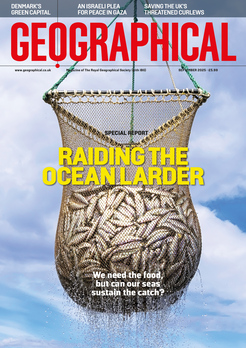
Fireflies and glowworms, like most insects, are struggling. Around the world, we are starting to safeguard these magical but little-understood bioluminescent beetles
Report by Simon Payne
The slap of the inky-black Chao Phraya River on the bow of the longtail boat is the only sound as we skirt the edge of Bang Krachao, an oxbow island in the heart of Bangkok. On the other bank are the bright lights of skyscrapers and the floodlit docks, but Bang Krachao is swathed in darkness, thanks largely to the campaigning spirit of Sukit Plubchang and the firefly centre he established when he returned to his childhood island 15 years ago. Now over 70, he devotes himself to preventing this green oasis of jungle and farms from being engulfed by the city. All in the pursuit of protecting fireflies.
Straggly ten-metre-high lamphu trees overhang the river and Bang Krachao’s canals, and as the boat’s engine is cut, we glide towards a tree, lit up as if it’s Christmas. Hundreds of fireflies flash together in perfect unison. Occasionally, one flies off, and now and again, one seems to lose the rhythm. This is probably a female signalling back to a male that she’s interested.

‘There’s something special about glowworms and fireflies,’ says Sara Lewis, a professor at Tufts University in the USA, the author of Silent Sparks: The Wondrous World of Fireflies and a renowned expert on fireflies. ‘You just fall in love with them. There’s something very, very special about animals that can make their own light.’
This magic is reflected in many cultures, especially in Asia. In Japan, fireflies or hotaru have been celebrated for 1,000 years in art, poetry and myth – as a symbol of the coming of summer and as a metaphor for passionate love. Wan Jusoh, a senior lecturer in biodiversity and conservation at Monash University, Malaysia, tells me: ‘In Malaysia, if I ask my grandma, she says: “If you see a firefly, it means you see the spirits”.’ And in India, fireflies are called kita-mani – the gem among all insects.

Along with glowworms, fireflies fall within the Lampyridae family, which sits within the wider grouping of beetles. There are estimated to be at least 2,200 species of firefly distributed across temperate and tropical regions on every continent except Antarctica, from Tierra del Fuego to Canada, from Sweden to New Zealand. All share a talent for making their own light – bioluminescence – using a molecule called luciferin, which, when combined with oxygen, creates oxyluciferin. The chemical reaction that creates the glow can increase or decrease according to the flow of oxygen – giving the beetles on–off flash control.
New species are being discovered all the time. ‘There’s a high increase in the number of new species being described, especially from South America and South East Asia,’ Jusoh explains while telling me about her own discoveries of new firefly species in Asia.
Understanding an animal’s life cycle is critical to its conservation. The typical lifecycle of fireflies includes a larval stage that often lasts many months. Most species are carnivores as larvae, often eating snails. The larvae can emit light (to warn potential predators they aren’t good to eat) but often go unnoticed as they’re found on the ground, often in leaf litter. They then emerge as adult beetles; some can fly, some can’t. During this short adult stage, which can last mere days, the light show fires up as they desperately search for a mate. Some glow, some flash on and off and, most spectacularly, some flash in synchronised groups. According to Lewis, the fireflies ‘communicate with light signals’ that are ‘easy to decode’ and even easy to simulate. ‘You can kind of talk with fireflies quite easily, and you can figure out what it is they’re looking for,’ she says. They’re after mates – this is the light of love. A swipe right, Tinder for beetles

European Space Agency, Copernicus Sentinel-2
As the biologist EO Wilson put it: ‘Insects are the little things that run the world.’ It’s therefore extremely worrying that overwhelming evidence suggests that they’re in decline – both in species diversity and total numbers. Two review studies by Francisco Sanchez-Bayo and Kris Wyckhuys, from the universities of Sydney and Queensland respectively, have shown that 40 per cent of insects are at risk of extinction and, overall, they’re declining at an annual rate of 2.5 per cent, which over a century could wipe out insects entirely.
How do fireflies fit into this picture? We don’t really know, but systematic studies are being done to find out. In 2018, a Specialist Firefly Group was established by the International Union for the Conservation of Nature (IUCN), and global efforts have been made to ‘Red List’ fireflies – using scientific evidence to establish their conservation status. The IUCN assessments are ongoing – so far, 132 firefly species have been assessed – a little over five per cent of known species. Of those assessed, 97 per cent are either in decline or their population trend isn’t known; 15 per cent of species are vulnerable or threatened with extinction and for 53 per cent, there’s inadequate information to assess extinction risk.

Back in his home, which doubles as a firefly centre, Sukit Plubchang, slightly stooped, bespectacled and wearing a baseball cap, tells me: ‘When I was young, in the old days when there were no cars here, 20-metre trees were alight with fireflies. The river was lit up. Numbers have gone down a lot since then, with especially sharp declines in the last few years.’
David Smith, social change and biodiversity officer at UK-based charity Buglife, tells me that its ‘splat survey’ of all insects showed a 65 per cent decline and for glowworms, they’re seeing declines in both numbers and distribution. He isn’t optimistic about the IUCN’s assessment, which is due to be published this month.

Fireflies face many of the threats common to other species: development, land-use change and habitat loss are all critical threats. Insecticide and other pesticide use, which either targets the snail prey of larvae or kills fireflies as collateral damage, is also a cause of decline, as is water pollution.
‘Climate change and increased drought is a known threat to a lot of the Mediterranean firefly species,’ explains Lewis. ‘We don’t have any evidence yet, but we think extreme-precipitation events are another potential threat.’
Amid this bad news there have been some conservation successes. Fireflies used to be over-harvested in China, where they were used as romantic gifts or deployed in mass releases at theme parks. It was reported that in 2016, more than 17 million live fireflies were harvested. Grassroots campaigning by firefly conservation bodies led by campaigner Lei Ping and supported by state authorities has put an end to this.
However, the main conservation threat, and that most reported in the IUCN assessments, is artificial light at night, which is difficult to combat. Light pollution isn’t a threat unique to fireflies – it can have an impact on bird migration, attract moths or mislead sea turtles, for example – but it’s absolutely critical for fireflies. Unlike many other threats, it’s also unregulated. In 2022, Lewis and her Tufts colleague Avalon Owens published a Royal Society review article on the impact of artificial light on firefly behaviour. ‘We’ve learned a lot about the details of exactly how artificial light at night impacts firefly communication and reproduction,’ she says. ‘We’ve learned that under even dim artificial illumination at night, for most fireflies, it will completely quash the romance. It impairs males’ ability to find females and it messes with females switching their light on and off.’ Some colours seem to have more impact on fireflies than others, while increasingly popular low-energy LED lights seem to be especially disruptive.
David Smith from Buglife, who is heading the organisation’s Nurture the Night Shift campaign to reduce artificial nighttime light, explains: ‘We’re seeing, an exponential increase of light pollution year on year. It’s not treated in any way like any other source of pollution. It’s completely socially accepted.’

But there are signs of change. The Nurture the Night Shift campaign explains the effects of artificial light at night and provides information as to how individuals can help. ‘The main chunk of my work is trying to influence policymakers to take light pollution seriously,’ Smith says. ‘Ultimately, we would like to have legally binding targets.’
France, Slovenia, the Czech Republic, Croatia and regions of Italy and Mexico have already developed laws to reduce light pollution. There are also signs that the EU is moving towards recognising the need for light-pollution reduction and regulation. The Brno Appeal to reduce light pollution in Europe was adopted in 2022 and the Nature Restoration Law, which is currently being finalised, refers to light pollution being a ‘pertinent issue’. Stopping or reducing light pollution in ecosystems may be an objective of the new law.
Making sure that there are dark places with suitable firefly habitats has led to the creation of several firefly sanctuaries. Starting in the USA, these are beginning to appear around the world. Candace Fallon from the US-based Xerces Society for Invertebrate Conservation is supportive. ‘One of our programme’s goals over the coming years is to work with local conservation organisations and land trusts to establish more of these sanctuaries in areas with threatened or endemic species or high firefly species diversity,’ she says.
Not only do sanctuaries protect fireflies, they attract visitors. Firefly tourism can generate local income from fireflies, raise awareness and inspire further conservation, although there’s also a risk that unmanaged tourism only serves to increase light pollution. Pre-pandemic it was estimated that more than a million people a year travelled to see fireflies around the world. Guidelines for responsible firefly tourism were published in 2021.

The benefits of firefly conservation can potentially go far beyond preserving their magical displays. Many synchronous fireflies live in tidal mangrove areas, which protect coastal communities from storm surges and erosion, and provide nursery grounds for fish and other marine life. And artificial nighttime light has been linked to both physical and mental ill-health in humans; it disrupts our circadian rhythm. Lighting is also estimated to use 15 per cent of electricity in the developed (and arguably over-lit) world.
Back in Bangkok, as a plane rumbles overhead, Sukit tells me that Bang Krachao provides six million tonnes of oxygen a day; its clean air helps to reduce particulate-matter pollution in the traffic-clogged city.
With all this at stake, what of the future for fireflies? ‘We know enough already about their ecology and their behaviour, so we can go out and start protecting them. We’re going gangbusters on the problem of making sure there are fireflies around for future generations. We call it keeping the firefly magic,’ Lewis says.
Sukit smiles as I ask him about the future: ‘As long you can see the light, there is hope.’
• Professor Simon Payne is a nature writer specialising in extinction, conservation and rewilding and is Emeritus Professor at the University of Plymouth, UK. Follow his work on Instagram @brave_new_wild




